
Wine Culture and Information since 2002 - Volume 22
 Wine Culture and Information since 2002 - Volume 22 |
|
Issue 165, September 2017 |
Contents |
|
|
The Future of Vine and Wine |
|
Wine is the result of the evolution of culture, taste and fads which characterized the social aspects of past times. Moreover, it is the result of progress and technologies conceived and developed by man, that is the one who makes and appreciates wine. Nevertheless - and important as well - it is the result of the environment, territory and climate conditions of each single place. All these elements, considered as a whole, brings to the creation of that magic we call wine, the beverage fascinating men since many centuries and which accompanied his evolution. Wine has changed with men, according to their taste and culture, it will unavoidably continue doing so in the future as well. The beverage of Bacchus has also been affected by the changes of environment and climate occurred in the course of centuries, conditions not always determined by the will of Nature, indeed by the consequences of the wickedness of men. In recent years, the consequences of this wickedness seem to become more and more evident on the territory and environment, including wine, of course. One of the most evident effects can be observed in viticulture. Harvesting of grapes - for example - has been affected by significant changes: the moment of grape picking is today remarkably done in advance than in past years, about two weeks earlier. This is mainly because of the increasing of temperature, the grape ripens in advance and, at the same time, the quantity of sugar in berries is significantly higher. The most obvious consequence - not the only one, of course - is that the increasing of sugar determines a higher quantity of alcohol at the end of fermentation. More sugar also means less acidity, therefore the wine we get is evidently rounder and flatter - as well as more alcoholic - lacking of elegance and certainly being less agreeable and balanced. For example, twenty years ago the average alcohol by volume in wines was 12.5%, a value that - at those times - was considered pretty high although common. Today the average value is remarkably increased and no one is surprised to read in labels values as high as 14%. In order to give a better idea of the change, we should consider in order to get a 1% of alcohol by volume in a wine we need about 17 grams of sugar per liter. A value that, it should be noticed, changes according to the type of yeast conducting fermentation and other wine making factors. In order to give an even better idea of what this does mean, it is like adding - for each liter of grape juice - a generous tablespoon of sugar. It is not a negligible quantity, in particular if we consider that sugar is actually replacing the acidic substances in the must. Wine will have a more evident burning effect, it tastes more flat, roundness will be enhanced and the wine will seem to be lacking of that fundamental and “pleasing vivacity” for its balance. Consequences of global warming are also making possible and concrete what in the past was considered highly improbable, if not impossible. For a very long time it was in fact believed the Northern area of France was the geographic limit for the cultivation of vine. Beyond that limit climate was too cold and unfavorable for vine, therefore not suited for the cultivation of vineyards. Thanks to global warming, in recent years, viticulture is quite successful in the Southern lands of United Kingdom. This is something, today not considered a rare case anymore, particularly present in South Wales and England, with an interesting production of sparkling wines and other styles. It should be said ancient Romans were cultivating vines in the large island lying beyond the English Channel, however the result they got have never been - of course - satisfactory when compared to the more florid and well suited Gaul, the modern France. Some believe there will be a progressive desertification of Southern areas of Europe, with radical changes for the environment and therefore unavoidable changes for agriculture as well. In case this is going to be true, vine would certainly be one of the plants to be affected and will not be suited for the cultivation in this new climate: in those lands vineyards will disappear, including the beverage of Bacchus. In this disgraceful scenario - we strongly hope to never happen - viticulture of Southern Italy would undergo drastic changes. This is incredible if we think ancient Greeks called these lands - in particular what we call today Calabria - rich of grapes and giving good wine, Enotria Tellus, the land of vines and wine. The famous and elegant terroirs of France would also be affected by these changes. In particular the magnificent and amazing lands of Burgundy, generous of very elegant and inimitable red wines from Pinot Noir and, nevertheless, Champagne with its renowned bubbles. Like to say - by quoting the words of Aristodemus, from the same name tragedy written by Vincenzo Monti - “if Messenia is weeping, Sparta is not laughing”. Because of the future changes we are very likely and unavoidably to face - while hoping men can find a solution before worse consequences could happen - some are remedying things differently. In Australia, for example, in recent times, vintners are replacing the so called international varieties with those common in warmer Mediterranean areas. It seems some are considering replacing Cabernet Sauvignon, Merlot and Syrah with Sangiovese, Tempranillo and Sagrantino, varieties clearly more suited for warm climates. A change also suggested by the well known enterprising spirit of Australian wine making that, having no traditional “burden” to carry on, they never had problems in adopting new varieties and wine making techniques from other countries. The problem is serious - indeed, very serious - and it is of course banal saying “we need to do something”. We do not in fact need of the efforts and good will of each one of us, as this is - undoubtedly - a problem requiring a choral action from everybody, in particular those having political powers. As this is something happened because of the stupid selfishness and wickedness of man, it would be the very least to prove we still have some intelligence and wisdom which can be defined like so. And we should also prove we can make a good use of them. And even in a hurry. Antonello Biancalana
|
||||
Contrasts of Cortese and InzoliaPiedmont and Sicily compared in our glasses with two white berried grapes, capable of giving wines of interesting versatility and wine making quality |
|
This month, in our glasses, we are going again to compare two white wines, with a tasting by contrast featuring two geographically distant grapes. It is not the first time we are going to examine grapes typical in distant places, a characteristic allowing us - among the many things - to understand the influence of different climate conditions. Differences between the two grapes, of course, are not only depending on the respective environment in which they are cultivated in, indeed - and in particular - on their specific qualities. These differences will let us understand better the two grapes of our tasting, because of the evident contrast existing in their wines. This month we will evaluate Cortese - a white berried grape from Piedmont, in particular from the Southern area of the region - and Inzolia, one of the glories of Sicily and also found in Tuscany. Cortese is the variety used for the production of the famous white wines of Gavi - in province of Alessandria - one of the areas of Piedmont ranking as DOCG, Denominazione d'Origine Controllata e Garantita (Denomination of Controlled and Guaranteed Origin). Cortese is also found in other areas of Piedmont, however it is Gavi to represent the area producing the best expression and notoriety. Inzolia, the variety we will compare to Cortese, is typically associated to Sicily - its homeland - in particular the Western area of the island. Used for the production of some Marsala styles, the grape from Sicily has widely proven to make white table wines of remarkable character and elegance. Inzolia is also found in the territory of Tuscan Maremma and Elba island, here known as Ansonica. Both Cortese and Inzolia have a good versatility and are used with different wine making techniques, from inert containers to casks and, in case of Cortese, good results have also been obtained in sparkling wines making.
|
|
Cortese is a white berried variety of Piedmont and it is used in the production of many white wines of the region, of which the most famous one certainly is Gavi. This variety is mainly found in the Southern territory of Piedmont and it is also used for the production of some white wines of Colli Tortonesi and Monferrato areas. Outside Piedmont, Cortese is found in Veneto, in particular in the territory of Custoza and used for the production of the same name white wine. In these lands Cortese is known as Bianca Fernanda. Cortese is also found in Lombardy, in particular in the territory of Oltrepo Pavese. Like already said, Gavi is the area in which Cortese has its best expression - also in terms of quality - thanks to the conditions of the territory and the many wine styles used for the production. In this territory - in fact - producers have proven the good versatility of Cortese, by making wines in inert containers and wooden casks, last but not the least, sparkling and sweet wines. The origin of Cortese grape is not clear, also because of the lack of historical and written proofs which could let us understand and define its origin better. The most supported theory wants Cortese to be originated from the province of Alessandria. This theory is also supported by the evident reason of the high concentration of Cortese vineyards found in the territories of Gavi and Tortona, areas in which Cortese wines have their best expression. It is known for sure, thanks to documents of the past, Cortese was already common in Piedmont since 1700s. It will be at the end of the 1800s we will have a more complete and better description of Cortese, in particular thanks to the work of professors Pierpaolo Demaria and Carlo Leardi dedicated to the grape varieties of the territory of Alessandria. Because of phylloxera, Cortese was progressively replaced in vineyards by other varieties, something which significantly compromised its presence in Piedmont. It will be only in the 1950s, also thanks to the interest shown by the famous writer and director Mario Soldati, producers will be interested in Cortese again and resumed making wines from this grape.
|
||||
|
Today Inzolia is, with no doubt, one of the most important and interesting white berried grapes of Sicily. After having been used, almost exclusively, for the production of Marsala and Vermouth, today Inzolia is mainly used for the making of table wines. Thanks to some producers, this Sicilian white variety has given excellent results in making interesting wines, also having a remarkable longevity and class. Inzolia is protagonist in many Denominazione d'Origine Controllata wines of Sicily, in particular in the provinces of Trapani, Agrigento, Caltanissetta and Palermo. It is believed Inzolia was introduced to Sardinia from Sicily and, from here, introduced to the territory of modern Tuscan Maremma, where it is known as Ansonica. In this territory Inzolia seems to confirm its special relationship with islands, by becoming known and common in Elba and Giglio islands as well. Inzolia is believed to be an indigenous grape of Sicily, however this theory is not supported by many. For some it is a variety of Greek origins and introduced to the territory today corresponding to Calabria and, from here, introduced to Sicily. For others, Inzolia was introduced to Sicily at the times of the dominion of Normans. The Sicilian origin of this variety is however the most probable, also supported by some genetic relations Inzolia has in common with other indigenous grapes of this island. This white berried variety has however proven, both in Sicily and in Tuscany, to make interesting wines, as well as having a good wine making versatility. If once this grape was mainly used for the production of fortified wines - such as Marsala and Vermouth - today Inzolia is the protagonist of elegant and interesting white wines. Inzolia however remains one of the great protagonists of Marsala wines, used in Oro and Ambra styles with Grillo, Catarratto and Damaschino grapes.
|
Our tasting by contrast will have as protagonists wines produced with 100% Cortese and Inzolia, in both cases vinified in inert containers, preferably steel tanks. Choosing a Cortese wine is, like to say, very simple as we will pick a bottle coming from the most significant and famous territory for this grape: Gavi. As for Inzolia, we will choose a wine from its homeland - Sicily - however, as this grape is widely common in this island, differences can also be substantial according to the area. We will choose a wine made from 100% Inzolia from the Western part of Sicily, in province of Trapani, an area in which are found many DOC wines made from this grape. Among the many are mentioned Alcamo, Delia Nivolelli and Erice. On this regard, we should notice the production disciplinary for these wines provide for a minimum 85% of Inzolia, we will therefore make sure our wine is made with this variety only. The two wines will be served at a temperature of 10 °C (50 °F) in tasting glasses. Let's pour the two wines in their glasses and start our tasting by contrast. The first wine we will examine is Gavi, made with Cortese grape. Tilt the glass on a white surface and evaluate the color and transparency of wine at the base of the glass. Cortese shows an intense and brilliant greenish yellow color with a very high transparency, allowing a perfect vision of the object put between the glass and white surface. Nuances of wine, observed towards the opening of the glass, where the liquid mass is thinner, show a greenish yellow color. Let's now pass to the observation of Inzolia: at the base of the glass we will see a brilliant straw yellow, sometimes having golden yellow hues as well. Also in this case, transparency is very high. Nuances of Inzolia show straw and greenish yellow colors. Let's now compare both glasses by placing them side by side: differences in color are evident and, of the two, Inzolia is the one usually showing a more intense and deep color. Two different grapes having different characters and, of course, giving distant wines. Not only divided by a long and substantial geographic distance but also - and above all - evident organoleptic and enological diversities. Differences between Cortese and Inzolia are evident in every organoleptic aspect. Cortese usually gives wines with fresh aromas and a body of moderate structure; Inzolia gives to the senses wines with a more mature profile and an evident fuller body than the grape from Piedmont. According to an olfactory point of view, Cortese expresses aromas of flowers and fruits, in particular apple, pear, plum, hawthorn and broom, usually followed by a pleasing hint of almond and mineral sensations. To the nose Inzolia too expresses aromas of flowers and fruits, however in this case they have an evidently “riper” character, with clean aromas of citrus fruits, as well as apple, pear and plum, to which follow peach and, sometimes, jasmine. Let's now proceed with the olfactory evaluation of our wines, starting from the wine produced with Cortese grape. By holding the glass in vertical position and without swirling, let's do a first smell, therefore evaluating the opening of the wine. From the glass are appreciated intense and clean aromas of apple, pear and hawthorn, evidently agreeable. Now swirl the glass, in order to favor the oxygenation of the wine and therefore the development of other aromas. The second smell completes the wine with aromas of broom, peach, plum, pineapple and, frequently, a pleasing almond aroma. Let's now pass to the examination of Inzolia's olfactory profile and proceed with the evaluation of opening. We will perceive intense and clean aromas of pear, apple and citrus fruits, frequently followed by broom, very agreeable. After having swirled the glass, let's do a second smell which will complete the olfactory profile of the wine with hawthorn, peach, almond, plum and, frequently, the elegance of pineapple. The next phase of our tasting by contrast will evaluate the gustatory aspect of the two wines. Just like in the previous phases, the first wine we will examine is Gavi, produced with Cortese grape. Let's take a sip and evaluate the attack of the wine, that is the gustatory sensations perceived at the beginning of the evaluation. In the mouth is perceived the pleasing crispness given by acidity, well balanced by alcohol, with a body which can be defined as average. In the attack can be perceived flavors of apple, pear and peach, confirming a good correspondence to the nose. Let's now pass to the evaluation of Inzolia's attack and take a sip of this wine. In the mouth is perceived, also in this case, the crisp sensation produced by acidity, properly balanced by alcohol and supported by a pleasing roundness, as well as a fuller body than Cortese. Correspondence to the nose is clearly good: in the mouth are perceived intense and pleasing aromas of apple, plum and pear, as well as almond. The last phase of our tasting by contrast will examine the final sensations left in the mouth by the wines after having swallowed them. The finish of the wine produced with Cortese is persistent, leaving in the mouth pleasing flavors of apple, pear and peach, frequently followed by almond. Moreover, we will also perceive the pleasing sensation of crispness certainly inviting us to appreciate the wine again. The finish of Inzolia is equally persistent leaving in the mouth sensations recalling pear, plum and apple, also in this case followed by almond. The sensation of crispness is also in this case very evident, however - compared to Cortese - the perception of body in more intense in Inzolia. On the other hand, the overall sensation given by Cortese is about a lighter wine however elegant and agreeable, characterized by a higher acidity and a roundness clearly lower than Inzolia.
|
||||||||
Wines of the Month |
|
|
|
Score legend Prices are to be considered as indicative. Prices may vary according to the country or the shop where wines are bought |
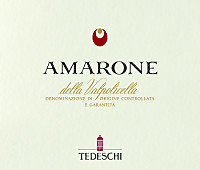
|
|
Amarone della Valpolicella 2013 |
|
| Tedeschi (Veneto, Italy) | |
 Corvina (30%), Corvinone (30%), Rondinella (30%), Rossignola, Oseleta, Negrara, Dindarella (10%) Corvina (30%), Corvinone (30%), Rondinella (30%), Rossignola, Oseleta, Negrara, Dindarella (10%) | |
| Price: € 30.00 | Score: |
 Intense ruby red and nuances of garnet red, little transparency. Intense ruby red and nuances of garnet red, little transparency. Intense, clean, pleasing, refined and elegant, starts with hints of
plum, blackberry and black cherry followed by aromas of dried violet,
blueberry, tobacco, vanilla, chocolate, pink pepper, mace and menthol. Intense, clean, pleasing, refined and elegant, starts with hints of
plum, blackberry and black cherry followed by aromas of dried violet,
blueberry, tobacco, vanilla, chocolate, pink pepper, mace and menthol.
 Tannic attack and however balanced by alcohol, full body, intense
flavors, pleasing roundness. Tannic attack and however balanced by alcohol, full body, intense
flavors, pleasing roundness.
 Persistent finish with flavors of plum, blackberry and black cherry. Persistent finish with flavors of plum, blackberry and black cherry. 3 years in cask, 6 months in bottle. 3 years in cask, 6 months in bottle. |
|
 Game, Stewed and braised meat, Roasted meat, Hard cheese Game, Stewed and braised meat, Roasted meat, Hard cheese |
|
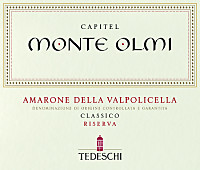
|
|
Amarone della Valpolicella Classico Riserva Capitel Monte Olmi 2011 |
|
| Tedeschi (Veneto, Italy) | |
 Corvina (30%), Corvinone (30%), Rondinella (30%), Oseleta, Negrara, Dindarella, Croatina, Forselina (10%) Corvina (30%), Corvinone (30%), Rondinella (30%), Oseleta, Negrara, Dindarella, Croatina, Forselina (10%) | |
| Price: € 60.00 | Score: |
 Deep ruby red and nuances of garnet red, little transparency. Deep ruby red and nuances of garnet red, little transparency. Intense, clean, pleasing, refined and elegant, starts with hints of
blackberry, black cherry and plum followed by aromas of dried violet,
blueberry, black currant, chocolate, iris, leather, tobacco, cinnamon,
mace, pink pepper, licorice, vanilla and menthol. Intense, clean, pleasing, refined and elegant, starts with hints of
blackberry, black cherry and plum followed by aromas of dried violet,
blueberry, black currant, chocolate, iris, leather, tobacco, cinnamon,
mace, pink pepper, licorice, vanilla and menthol.
 Tannic attack and however balanced by alcohol, full body, intense
flavors, pleasing roundness. Tannic attack and however balanced by alcohol, full body, intense
flavors, pleasing roundness.
 Very persistent finish with long flavors of blackberry, black cherry
and plum. Very persistent finish with long flavors of blackberry, black cherry
and plum.
 4 years in cask, 6 months in bottle. 4 years in cask, 6 months in bottle. |
|
 Game, Stewed and braised meat, Roasted meat, Hard cheese Game, Stewed and braised meat, Roasted meat, Hard cheese |
|
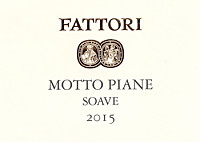
|
|
Soave Motto Piane 2015 |
|
| Fattori (Veneto, Italy) | |
 Garganega Garganega | |
| Price: € 11.30 | Score: |
 Deep straw yellow and nuances of golden yellow, very transparent. Deep straw yellow and nuances of golden yellow, very transparent. Intense, clean, pleasing, refined and elegant, starts with hints of
quince, peach and medlar followed by aromas of pear, hawthorn, citrus
fruits, broom, almond, pineapple, honey, plum and sage. Intense, clean, pleasing, refined and elegant, starts with hints of
quince, peach and medlar followed by aromas of pear, hawthorn, citrus
fruits, broom, almond, pineapple, honey, plum and sage.
 Crisp attack and however balanced by alcohol, good body, intense
flavors, pleasing roundness. Crisp attack and however balanced by alcohol, good body, intense
flavors, pleasing roundness.
 Persistent finish with flavors of quince, medlar and honey. Persistent finish with flavors of quince, medlar and honey. Made from Garganega grapes dried for 40 days, aged in steel tanks
and cask. Made from Garganega grapes dried for 40 days, aged in steel tanks
and cask.
|
|
 Pasta and risotto with vegetables and crustaceans, Mushrooms soups, Sauteed white meat, Roasted fish Pasta and risotto with vegetables and crustaceans, Mushrooms soups, Sauteed white meat, Roasted fish |
|
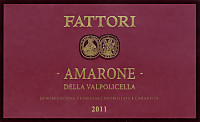
|
|
Amarone della Valpolicella 2011 |
|
| Fattori (Emilia Romagna, Italy) | |
 Corvina (65%), Corvinone (15%). Rondinella (10%), Other Grapes (10%) Corvina (65%), Corvinone (15%). Rondinella (10%), Other Grapes (10%) | |
| Price: € 48.20 | Score: |
 Intense ruby red and nuances of garnet red, little transparency. Intense ruby red and nuances of garnet red, little transparency. Intense, clean, pleasing, refined and elegant, starts with hints of
blackberry, plum and black cherry followed by aromas of dried violet,
blueberry, chocolate, cinnamon, tobacco, mace, face powder, leather,
vanilla and menthol. Intense, clean, pleasing, refined and elegant, starts with hints of
blackberry, plum and black cherry followed by aromas of dried violet,
blueberry, chocolate, cinnamon, tobacco, mace, face powder, leather,
vanilla and menthol.
 Tannic attack and however balanced by alcohol, full body, intense
flavors, pleasing roundness. Tannic attack and however balanced by alcohol, full body, intense
flavors, pleasing roundness.
 Very persistent finish with long flavors of blackberry, black cherry
and plum. Very persistent finish with long flavors of blackberry, black cherry
and plum.
 36 months in cask. 36 months in cask. |
|
 Game, Braised and stewed meat, Roasted meat, Hard cheese Game, Braised and stewed meat, Roasted meat, Hard cheese |
|
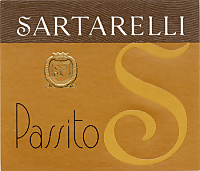
|
|
Verdicchio dei Castelli di Jesi Passito 2015 |
|
| Sartarelli (Marches, Italy) | |
 Verdicchio Verdicchio | |
| Price: € 24.00 - 500ml | Score: |
 Intense golden yellow and nuances of golden yellow, transparent. Intense golden yellow and nuances of golden yellow, transparent. Intense, clean, pleasing and refined, starts with hints of raisin,
dried fig and almond followed by aromas of quince jam, medlar, pear jam,
citrus fruits peel, honey, walnut husk and nail polish. Intense, clean, pleasing and refined, starts with hints of raisin,
dried fig and almond followed by aromas of quince jam, medlar, pear jam,
citrus fruits peel, honey, walnut husk and nail polish.
 Sweet and round attack, however balanced by alcohol, good body, intense
flavors, pleasing crispness. Sweet and round attack, however balanced by alcohol, good body, intense
flavors, pleasing crispness.
 Persistent finish with flavors of raisin, dried fig and almond. Persistent finish with flavors of raisin, dried fig and almond. Aged in steel tanks. Aged in steel tanks. |
|
 Hard cheese, Dried fruit tarts Hard cheese, Dried fruit tarts |
|
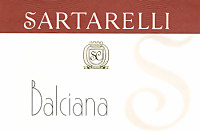
|
|
Verdicchio dei Castelli di Jesi Classico Superiore Balciana 2014 |
|
| Sartarelli (Marches, Italy) | |
 Verdicchio Verdicchio | |
| Price: € 38.00 | Score: |
 Intense golden yellow and nuances of golden yellow, very transparent. Intense golden yellow and nuances of golden yellow, very transparent. Intense, clean, pleasing, refined and elegant, starts with hints of
apricot, quince and citrus fruits followed by aromas of ripe peach, honey,
almond, plum, rosemary, broom, candied fruits, hawthorn, hazelnut,
pineapple and mineral. Intense, clean, pleasing, refined and elegant, starts with hints of
apricot, quince and citrus fruits followed by aromas of ripe peach, honey,
almond, plum, rosemary, broom, candied fruits, hawthorn, hazelnut,
pineapple and mineral.
 Crisp attack and however balanced by alcohol, full body, intense
flavors, pleasing roundness. Crisp attack and however balanced by alcohol, full body, intense
flavors, pleasing roundness.
 Very persistent finish with long flavors of quince, apricot, honey and
almond. Very persistent finish with long flavors of quince, apricot, honey and
almond.
 8 months in steel tanks, 6 months in bottle. 8 months in steel tanks, 6 months in bottle. |
|
 Stuffed pasta with mushrooms, Roasted fish, Roasted white meat, Cheese Stuffed pasta with mushrooms, Roasted fish, Roasted white meat, Cheese |
|
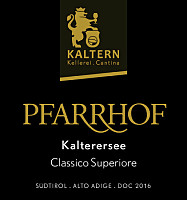
|
|
Lago di Caldaro Classico Superiore Pfarrhof 2016 |
|
| Kellerei Kaltern-Caldaro (Alto Adige, Italy) | |
 Schiava (95%), Lagrein (5%) Schiava (95%), Lagrein (5%) | |
| Price: € 12.00 | Score: |
 Brilliant ruby red and nuances of ruby red, moderate transparency. Brilliant ruby red and nuances of ruby red, moderate transparency. Intense, clean, pleasing and refined, starts with hints of cherry,
raspberry and strawberry followed by aromas of plum, almond, cyclamen,
blueberry, violet and hints of vanilla. Intense, clean, pleasing and refined, starts with hints of cherry,
raspberry and strawberry followed by aromas of plum, almond, cyclamen,
blueberry, violet and hints of vanilla.
 Properly tannic attack with a pleasing crispness, however balanced by
alcohol, good body, intense flavors, pleasing roundness. Properly tannic attack with a pleasing crispness, however balanced by
alcohol, good body, intense flavors, pleasing roundness.
 Persistent finish with flavors of cherry, raspberry and strawberry. Persistent finish with flavors of cherry, raspberry and strawberry. 6 months in steel tanks and cask. 6 months in steel tanks and cask. |
|
 Meat appetizers, Cold cuts, Sauteed meat, Roasted white meat Meat appetizers, Cold cuts, Sauteed meat, Roasted white meat |
|
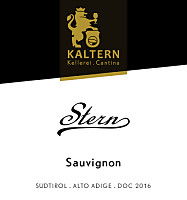
|
|
Alto Adige Sauvignon Stern 2016 |
|
| Kellerei Kaltern-Caldaro (Alto Adige, Italy) | |
 Sauvignon Blanc Sauvignon Blanc | |
| Price: € 12.00 | Score: |
 Pale straw yellow and nuances of greenish yellow, very transparent. Pale straw yellow and nuances of greenish yellow, very transparent. Intense, clean, pleasing, refined and elegant, starts with hints of
gooseberry, nettle, elder flowers followed by aromas of peach, bell pepper,
pineapple, mango, apple, acacia, grapefruit and mineral. Intense, clean, pleasing, refined and elegant, starts with hints of
gooseberry, nettle, elder flowers followed by aromas of peach, bell pepper,
pineapple, mango, apple, acacia, grapefruit and mineral.
 Crisp attack and however balanced by alcohol, good body, intense
flavors, agreeable. Crisp attack and however balanced by alcohol, good body, intense
flavors, agreeable.
 Persistent finish with flavors of gooseberry, peach and mango. Persistent finish with flavors of gooseberry, peach and mango. A small part ages for 5 months in cask. A small part ages for 5 months in cask. |
|
 Fish and vegetable appetizers, Risotto with vegetables and crustaceans, Fried fish, Dairy products Fish and vegetable appetizers, Risotto with vegetables and crustaceans, Fried fish, Dairy products |
|
News |
|
In this section are published news and information about events concerning the world of wine and food. Whoever is interested in publishing this kind of information can send us a mail to our address.
|
AquavitaeReview of Grappa, Distillates and Brandy |
|
|
||||||||||||||
Wine Guide ParadeMay 2017
|
| |||||||
Privacy Policy | |||||||


| Copyright © 2002-2024 Antonello Biancalana, DiWineTaste - All rights reserved |
| All rights reserved under international copyright conventions. No part of this publication and of this WEB site may be
reproduced or utilized in any form or by any means, electronic or mechanical, without permission in writing from DiWineTaste. |